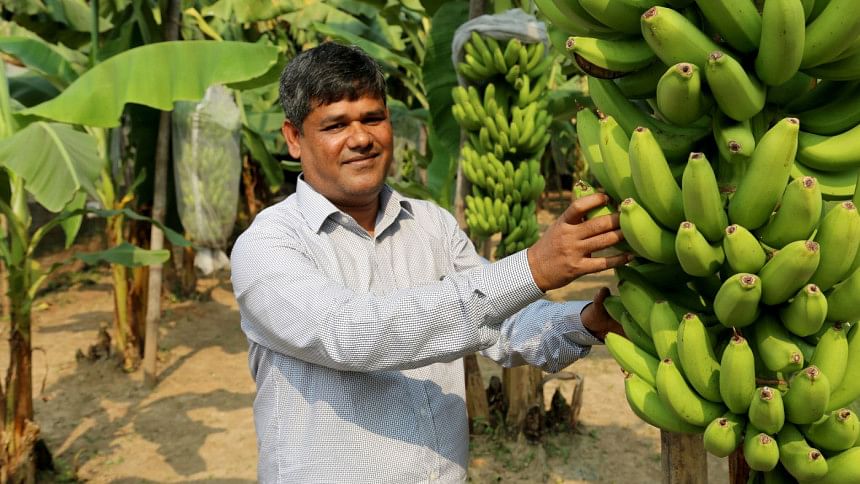G9 banana may turn into foreign income source

Banana is the second most-produced fruit crop in the world next to wheat, paddy and maize. The centre of banana production is the Asia-Pacific region. India occupies a large portion of the world banana market. The banana market is growing day by day, resulting increase in banana production. According to the World Food and Agriculture Organization (FAO), the total banana production worldwide was 69 million tonnes in 2000 and it increased to 116 million tonnes by 2020, valued at USD 31 billion. Only 15 percent of this production is traded in the international market. However being a country, ruled by the agricultural economy, Bangladesh did not give the slightest effort to enter the international market.
Delwar Hossain, a farmer from Gazipur's Sreepur upazila, has been calculating the international market for bananas for a long time. He told me one and a half years ago about his thoughts on trying to grab the international market by cultivating high-quality bananas. He said the bananas we cultivate cannot enter the international market. It requires beautiful shape with an eye-catchy look and wonderful taste, added Delwar. Delwar and his wife Shelly's initiative in banana has been talked about everywhere. Meanwhile, everything came to a standstill due to the impact of COVID-19 outbreak. "Like everyone else, I was under lockdown for five months," said Delwar. During the lockdown period, Delwar has moved forward slowly but steadily. I went to visit his banana orchard in the first week of December after he called me in November 2020. Delwar has set up a G9 (Grand Naine) banana orchard in Sreepur's Kewa village.
During one of my tours to China in 2018, I first came to learn about G9 banana when it was served on the flight. I was accompanied by my two colleagues, Aditya Shaheen and Tanbhir Ashik. The bananas didn't have any spot and it was so fresh. The French word 'Grand' means tall and 'Naine' means short. In that sense, the name Grand Naine stands for 'Tall-Short.' This fruit variety is tall in shape but its tree is relatively short. Delwar planted 70 tissue culture G9 plant on 10 decimals of land, only eight months (April 2020) back. I asked him, what is the reason for planting G9 bananas when so many varieties of bananas around? Delwar said this banana has many qualities such as higher yields, disease-resistant and tasty. The tree is relatively small in size and storms or winds can't ruin them. After ripening or harvest, the variety last for a relatively long time, meaning they do not rot. Farmers get three yields in two years. All the bananas are same in size and there is no spot on it.
Delwar first saw G9 banana at an agricultural exhibition in Pune, India. He then brought some tissue culture plants from there and started his dream project of cultivating G9 banana since then. He was more into it as he could use moderate fertilizers with no pesticides at all. What he did was he wrapped the cluster of bananas with a special paper. As soon as I opened one such paper, the banana cluster came out. All the bananas from the top to the bottom of the cluster were of same size and the colour was still green. However, it was clear that it will look nice when they will ripen. They will bear the same colour for about one and a half months after harvest. There is no spot on a single banana. Delwar said the best thing about commercial G9 cultivation is it lasts a long time. The nutritional value of G9 bananas is quite good. However, Delwar's goal is to cultivate this banana and grab the export market. Delwar needs a banana processing centre, but that is very expensive. His demand to the government is to set up processing centres in different regions of the country. He firmly believes a world standard processing centre will help the G9 bananas ripen better and its colours will become fresher to enter the global banana market.
However, in terms of export, it is necessary to build a commercial orchard first. Tissue culture plants should spread across the country in a planned way. In this case, Delwar is emphasizing building a quality laboratory. I asked him if a farmer wants to cultivate G9 on one bigha (0.33 acres) orchard, what would be his calculation for the costs and profit. Delwar said 380 trees can be planted on one bigha of land and the cost per tree in the first year will be Tk 180 (USD 2.12). This money includes all the expenses starting from the price of plants, fertilizer and irrigation, and wrapping the banana clusters. At least 160 bananas will come from each tree in the first year which could be sold at around a minimum of Tk 500 (USD 5.90). As a result, it is not very difficult to get Tk 1.2 lakh profit, deducting the production cost from one bigha of land. The production expenses during the second crop cycle will be reduced to less than Tk 50 (USD 0.58) per tree, a year. Then the profit will go quite high, as you can easily assume.
In the meantime, 1,200 tissue culture plants have been distributed among farmers. Delwar got the first yield as expected and now he is expecting government initiatives to expand the G9 varieties. By the way, there are many potential places in the country where commercial banana orchards can start operating. Many farmers have already become interested to initiate G9 banana cultivation.
Today's farming perspective is much more diverse. Diversity competition is going on in the commercial farming scenario as well. In this case, the entrepreneurial farmer is far ahead. Especially those who are researching the world market and farming trends, techniques and technologies, are introducing new fruit crops in the country's soil. Delwar is such a promising entrepreneur. I believe that Delwar's efforts will effectively work in the countrywide extension of the G9 variety of bananas. I also hope the government will take necessary initiative so that G9 can enter the international market. Advanced deepest respect for the Language Martyrs on the International Mother Language Day; the day also marks another glorious occasion as the illustrious agricultural TV programme Hridoye Mati O Manush is going to step into its 18th year of broadcasting.

 For all latest news, follow The Daily Star's Google News channel.
For all latest news, follow The Daily Star's Google News channel. 



Comments